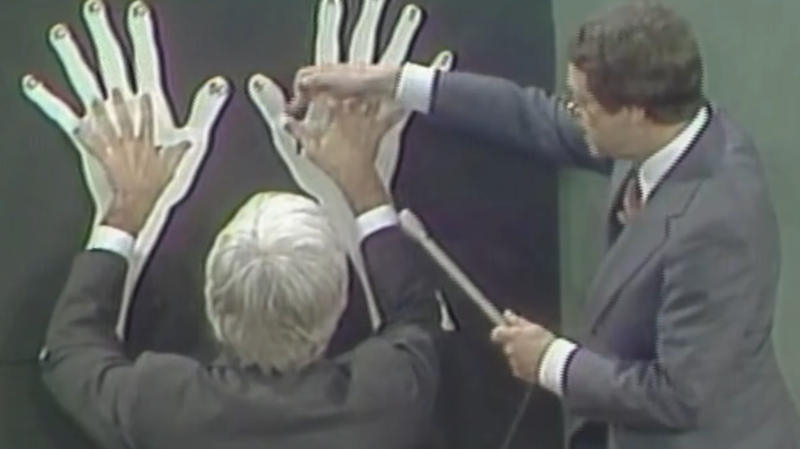If you are a certain age, you probably remember the ads and publicity around Chisanbop — the supposed ancient art of Korean finger math. Was it Korean? Sort of. Was it faster than a calculator? Sort of. [Chris Staecker] offers a great look at Chisanbop, not just how to do it, but also how it became such a significant cultural phenomenon. Take a look at the video below. Long, but worth it.
Technically, the idea is fairly simple. Your right-hand thumb is worth 5, and each finger is worth 1. So to identify 8, you hold down your thumb and the first three digits. The left hand has the same arrangement, but everything is worth ten times the right hand, so the thumb is 50, and each digit is worth 10.
With a little work, it is easy to count and add using this method. Subtraction is just the reverse. As you might expect, multiplication is just repeated addition. But the real story here isn’t how to do Chisanbop. It is more the story of how a Korean immigrant’s system went viral decades before the advent of social media.
You can argue that this is a shortcut that hurts math understanding. Or, you could argue the reverse. However, the truth is that this was around the time the calculator became widely available. Math education would shift from focusing on getting the right answer to understanding the underlying concepts. In a world where adding ten 6-digit numbers is easy with a $5 device, being able to do it with your fingers isn’t necessarily a valuable skill.
If you enjoy unconventional math methods, you may appreciate peasant multiplication.















This reminds me of an article by SF writer Frederik Pohl, “How To Count On Your Fingers”, where he explains how to deal with numbers from 0 to 1023, using your ten fingers as binary digits.
With the downside that to convert the binary number back to something you can tell other people, you need to do 3-digit additions :)
There is a group which attempted to introduce counting in twelves, as it divides a lot more easily than ten. It can also be counted on one hand by counting the segments of your digits. It feels quite a bit like this Chisanbob, as it is quite overcomplicated, but it may have a slight improvement in learning early maths.
https://www.youtube.com/watch?v=pqGyUvZP0Zg
I had this same idea as a teenager, except I also used the tops or tips of my fingers, because I wanted to count in hexidecimal.
Interesting to hear other people have thought of this!
And hope that your mother doesn’t walk in the room when you have a result of 132.
In the second time through 4th grade I came up with a way of counting dots I mentally overlayed on numbers kinda like dots on dominoes. The pencil counts each dot and I have the result without mental anguish or error. I still use it decades later. I learned about 10 years ago that experts identified a subset of dyslexia that is distinctly mathematical. I whooped with joy knowing something was hidden from me.
Then I read in an online 1930’s pop-sci zine about that very same diagnosis which they even gave a medical sounding name. Damming proof that educators don’t want to recognize this and deal with it. Disabled students are excused from gym class but I had to put up with math and had no choice. I understood differentiation and integration form a physical sense but collage EET had me drop out when we got to calculus. My dad only had a 6th grade education but could crunch numbers well. He had a full career being a human computer at a big aluminum producer as order records clerk. He was of no help with my grade school homework.
You either get it or you don’t.
Except when you have to do it regularly, repeatedly and rapidly. Think something like counting yards of lumber in a yard, or counting change at the marketplace without a cash register.
Whipping out your phone, unlocking it, opening the calculator app and tapping in the numbers is far slower than simply counting with your fingers.
I’ve been using a version of “chisanbop” to tally large numbers, except it’s just counting to 5 twice with the right hand (fingers up, then down) and keeping the 10’s in the left hand. I don’t remember when I came up with the system or where I learned it.
Basically, your thumb goes up for 1, then index finger up for 2, middle finger up 3, ring finger 4, all fingers 5. Then you drop the thumb for 6, index finger down 7, middle finger down 8, ring finger down 9, little finger down 10 and carry to the left hand. There is a unique combination of fingers up and down for every number 1…9.
If you do that with both hands, you can count up to 99.
Counting down is more difficult though, because dropping down the little finger in my right hand drops the ring finger as well. All the fingers in my left hand move independently.
ha. i have the same problem. and when i straighten my right ring finger, my pinky automagically goes half way at least. left side, no prob.
I heard the explanation once that the muscles, tendons or nerves for these two fingers are somehow partially fused together. I can find a nerve pinch point near the elbow that makes only the pinky finger twitch, so it must be nerve cross-talk somewhere up the line.
Ah, from the good old days. Course people would still look at you funny when you took off your shoes.
https://www.amazon.com/Complete-Book-Fingermath-Accurate-Scientific/dp/0070376808
I was taught Chisanbop as a kid (around 4-5yo). I still count that way for tracking numbers greater than 5. Less often, for larger numbers, up to 1023, I use binary.